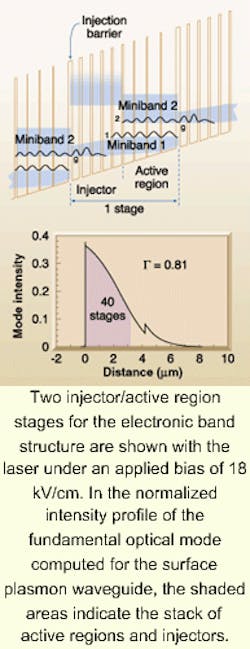Surface plasmon quantum-cascade laser emits at 19 µm

The longest-wavelength III-V semiconductor laser to date has been developed by researchers at Bell Laboratories (Lucent Technologies; Murray Hill, NJ). The device, which is based on a quantum-cascade (QC) configuration for the active material, operates at a wavelength close to 19 µm on interminiband transitions in graded superlattices. Peak output power is 14 mW/facet at 10 K, and laser action is possible at temperatures up to a maximum of 145 K.1
As defined by the researchers, surface plasmons are TM electromagnetic modes confined at the interface between materials with dielectric constants of opposite sign. Because negative dielectric constants are typical of metals below the plasma frequency, the occurrence of these modes at a metal-semiconductor interface offers a good waveguiding solution for QC lasers. The resulting device is competitive at wavelengths exceeding 15 µm, where the penetration depth in the absorptive metal layer, and thus waveguide losses, are reduced. The laser also is competitive when conventional technologies would require the growth of problematically thick cladding layers.
In the QC laser developed at Bell Labs, the undoped active regions rely on interminiband transition in chirped, appropriately graded superlattices, with the result being a large material gain even for a transition energy of 65 meV. The laser achieves population inversion between the states at the edge of the first minigap through unipolar electron injection via miniband transport.
The laser system has a stack of active regions bridged by injectors that extract electrons from the lower miniband of one superlattice active region and inject them into the second miniband of the following one (see figure). The 40 superlattice/injector stages were grown by solid-source molecular beam epitaxy (MBE) in an indium gallium arsenide/aluminum indium arsenide (InGaAs/AlInAs) lattice matched to indium-phosphide substrates low-doped to an ne of approximately 2 x 1017 cm-3 (electron count).
The scientists etched the wafer into 30- to 40-µm-wide ridges through the epilayers and deposited silicon dioxide on the sidewalls for insulation. This step was followed by the evaporation of top and back contacts, which left a large area on the top of the ridges open for deposition of a 300-nm-thick gold surface plasmon carrying layer. Ultimately, this processing produced epitaxially grown material about only 4 µm thick.
For experimental purposes, the ridges were cleaved into 0.37 to 1.5-mm-long laser bars. The bars were then soldered to copper plates, wire bonded, and mounted in a cryostat for measurements. Test results indicated several issues that require further study. For example, the scientists report that strong uncertainties characterize both the dielectric constants of metals and the simple free-carrier absorption model for the doped semiconductors. One result may be larger waveguide losses than estimated. In addition, the estimated external differential quantum efficiency of the system is currently about an order of magnitude lower than what is expected from a 40-period cascade, which could indicate that a few stages may not contribute to laser action. Still, the Bell Lab researchers believe the low threshold currents observed with the laser are promising, especially with future optimization of the device for higher temperatures and emission power.
Reference
- A. Tredicucci et al., Appl. Phys. Lett. 77, 2286 (Oct. 9, 2000).
About the Author
Paula Noaker Powell
Senior Editor, Laser Focus World
Paula Noaker Powell was a senior editor for Laser Focus World.